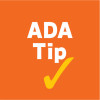Web Accessibility Perspectives
What Is Web Accessibility?
Under the Americans with Disabilities Act, federal law requires that all of our online content meet the requirements for web accessibility. Web Content Accessibility Guidelines (WCAG) are the standard for producing web content that is accessible to individuals with disabilities.
These guidelines seek to improve the experience for those with visual, auditory, memory, context, or physical mobility impairments.
What does this mean for a Content Manager?
All information or content presented by electronic means must also be accessible to those with a disability. This applies to web pages, broadcast email messages, and documents.
For example, content that is presented visually—like a promotional poster for a show—must also be available in non-visual format such as text. All images must be accompanied with meaningful text descriptions. Audible content—like the audio track on a video—must be available via closed captioning and/or a text transcript. For those with memory, context, and physical mobility impairments, careful structuring of content, with appropriate labelling is essential - good clear writing is the key there.
Making your content “accessible” does not have to be hard. Clear language and good structure are important for everyone and they are essential for accessibility.
Web accessibility is everyone’s responsibility, and it has to be “baked-in” form the start. For that reason, accessibility issues are addressed throughout the topics included in these training materials. You will see the notation “Accessibility Tip:” in topics such as adding images, tables, and anywhere else it is relevant.

Clear and Concise Content
The most essential part of accessibility is that you use good clear structure and clear writing. Content should be put together with simple language and clear formatting that is appropriate for the context. Make sure that sentences and paragraphs are short and clear, and unnecessary complex language should be avoided. Avoid artificial enthusiasm using over-punctuation! That’s! just! silly! Avoid insider-speak too.
Perspective’s on digital accessibility in a campus environment
The project mentioned here is no longer active. However, similar support is available here at Purchase College.
W3C’s Web Accessibility Perspectives Videos
Accessibility perspectives (why color contrast, large buttons, clear layouts, etc.)
Web accessibility is essential for people with disabilities and useful for all. Learn about the impact of accessibility and the benefits for everyone in a variety of situations:
- Keyboard Compatibility (link is external), What is “Keyboard Compatibility”? [video]
- Colors with Good Contrast (link is external), What is “Colors with Good Contrast”?[video]
- Clear Layout and Design (link is external), What is “Clear Layout and Design”? [video]
- Text to Speech (link is external), What is “Text to Speech”? [docx]
- Large Links, Buttons, and Controls (link is external), What is “Large Links, Buttons, and Controls”? [video]
- Video Captions (link is external), What is “Video Captions”? [video]
- Customizable Text (link is external), What is “Customizable Text”? [video]
- Voice Recognition (link is external), What is “Voice Recognition”? [video]
- Understandable Content (link is external), What is “Understandable Content”? [video]
- Notifications and Feedback (link is external), What is “Notifications and Feedback”? [video]
Status: Updated 15 September 2016. Editor and project lead: Shadi Abou-Zahra. Developed by the Education and Outreach Working Group (EOWG) with support from the WAI-DEV project, co-funded by the European Commission. Copyright © 2016 W3C ® (MIT ERCIM Keio, Beihang) Usage policies apply. This work is licensed under a Creative Commons Attribution-ShareAlike 4.0 International License. For attribution requirements, see the “Creative Commons License (CC)” section of Using WAI Material.